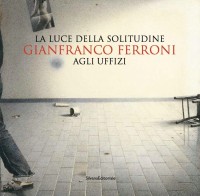By Mackenzie Constantinou (Lorenzo de’ Medici)
Since the 5th of May the room of the Reali Poste has had free admission and it exhibits the works of Gianfranco Ferroni, who is a Liovornese artist that naturalized to Milanese.
The visitor is greeted by a basic layout, which is characterized by dark walls and no explanatory panels. The only informational material is limited to two panels, which are in both Italian and English. One of the texts describes the general sense of the exhibition, while the other provides a short biography on the artist.
The works are arranged in chronological order, which illustrates the change in the style of Ferroni’s art. At the center of the exhibition is a large painting entitled Without Resurrection, which is both conceptual and physical. This was recently donated to the Uffizi. The work was displayed at the Venice Biennale in 1968. The central themes of the artist, such as the communist party, are depicted. The artist is attentive to the social and current affairs and the issues. These events are blended into the setting of this work. The exhibition highlights the distinction between the language of the artist before and after the sixties.
The works that occupy the right side of the display are mainly nightlife. The interior depicted is of unrecognizable piles of objects. Flashes of light fall on these objects, while the representation of the city is a maze of signs in motion. In seventies Ferroni transitioned to a more formal painterly style, where spaces became essential to the work as instances to diffuse light. Abandoing the theme of social issues the artist studies a topic more intimate, poetics and himself.
In this second phase, the spaces are empty expressing a sense of abandonment and the light creates a suspended atmosphere.
Ferroni’s art that has always had clear references to the great masters of the past, especially Vermeer and Caravaggio, the latter in particular. The work, Homage to Caravaggio was dedicated to the master and was clearly inspired by The Calling of Saint Matthew.
Ferroni’s relationship with light culminates in his still life, in which the rapport with the form is expressed in a light painting, almost Morandian, made of simple objects, which often belong to the craft of the artist.
La luce della solitudine. Gianfranco Ferroni agli Uffizi. Sala delle Reali Poste
Nello spazio delle Reali Poste è in corso dal 5 Maggio, con ingresso gratuito, la personale dell’artista livornese, naturalizzato milanese, Gianfranco Ferroni curata da Vincenzo Farinella.
Il visitatore è accolto da un allestimento molto essenziale caratterizzato da pareti scure e privo di pannelli esplicativi. Gli unici materiali informativi sono limitati a due pannelli, sia in inglese che in italiano, uno con il senso generale della mostra e l’altro con una breve biografia dell’artista.
Le opere, disposte secondo un criterio cronologico, documentano il cambiamento stilistico nell’arte di Ferroni. Il centro della mostra, sia concettuale che fisico, è la grande tela intitolata Senza resurrezione, recentemente donata agli Uffizi. In quest’opera, esposta alla Biennale di Venezia del ’68, si sommano le tematiche centrali elaborate dall’artista fino a quel momento; iscritto al partito comunista è molto attento al sociale e all’attualità, tematiche che fonde con un impostazione iconografica ispirata alle grandi pale a soggetto religioso della tradizione. L’ allestimento evidenzia la distinzione tra il linguaggio dell’artista prima degli anni sessanta e ciò che accade dopo.
Le opere che occupano la parte destra della mostra sono soprattutto notturni, gli interni sono ammassi di oggetti irriconoscibili sui quali cadono lampi di luce, così la rappresentazione della città è un groviglio di segni in movimento. Dagli anni settanta Ferroni approda ad una pittura più formale, in cui gli spazi diventano contenitori scarni, essenziali, irrorati da una luce diffusa. Abbandonate le tematiche sociali, vengono espressi temi più intimisti,i protagonisti di questa nuova poetica sono lo studio e l’artista stesso. In questa seconda fase gli spazi si svuotano esprimendo un senso di abbandono e la luce crea atmosfere sospese.
Lo studio diviene il tempio in cui si compie l’arte, un arte che ha sempre chiari i riferimenti ai grandi maestri del passato, soprattutto Vermeer e Caravaggio, a quest’ultimo in particolare dedica Omaggio a Caravaggio chiaramente ispirato a La vocazione di San Matteo.
Il rapporto con la luce, costante nell’arte di Ferroni trova il suo culmine nelle nature morte, in cui il rapporto con la forma si esplica in una pittura chiara, quasi Morandiana, fatta di oggetti semplici, spesso appartenenti al mestiere dell’artista.
